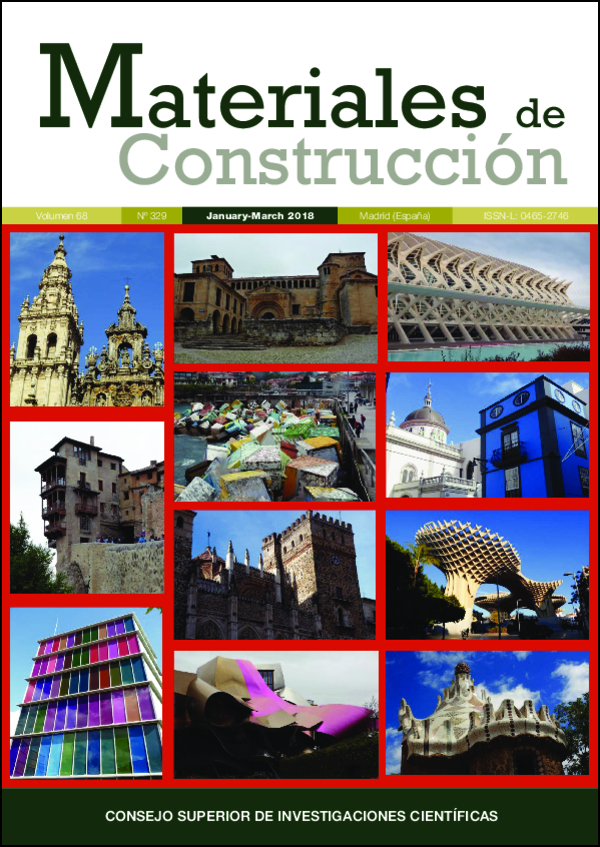Effect of Sporosarcina Pasteurii on the strength properties of compressed earth specimens
DOI:
https://doi.org/10.3989/mc.2018.12316Keywords:
Calcium carbonate, Organic material, Curing, Compressive strength, CharacterisationAbstract
Microbial biodeposition of calcite induction for improving the performance of rammed earth is a research area that must be analysed in a representative environment. This analysis must consider the compaction force, particle size distribution and curing process as production variables. This paper investigates the effects of adding specific bacteria, Sporosarcina Pasteurii, into compressed earth cubes and the effect of production variables. Uniaxial compressive tests and direct shear tests have been conducted for 80 specimens. The results indicate that calcite precipitation interacts with the drying process of clay/silt resulting in reducing the compressive strength, the apparent cohesion and the friction angle. Finally, bacterial activity, which is more likely in samples cured in a high humidity environment, tends to reduce the dilatancy effect.
Downloads
References
Easton, D., Wright, C. (2007). The Rammed Earth House. Vermont: Chelsea Green Publishing (2007)
Miccoli, L., Müller, U., Fontana, P. (2014). Mechanical behaviour of earthen materials: A comparison between earth block masonry, rammed earth and cob. Constr. Build. Mater., 61: 327–339. https://doi.org/10.1016/j.conbuildmat.2014.03.009
DeJong, J. T., Fritzges, M. B., Nüsslein, K. (2006). Microbially Induced Cementation to Control Sand Response to Undrained Shear. J. Geotech. Geoenvironmental Eng., 132(11): 1381–1392. https://doi.org/10.1061/(ASCE)1090-0241(2006)132:11(1381)
Stocks-Fischer, S., Galinat, J. K., Bang, S. S. (1999). Microbiological precipitation of CaCO 3. Soil Biol. Biochem., 31(11): 1563–1571. https://doi.org/10.1016/S0038-0717(99)00082-6
Ivanov, V., Chu, J., Stabnikov, V. (2015). Basics of Construction Microbial Biotechnology. In Biotechnologies and Biomimetics for Civil Engineering (pp. 21–56). Cham: Springer International Publishing (2015).
De Muynck, W., Debrouwer, D., De Belie, N., Verstraete, W. (2008). Bacterial carbonate precipitation improves the durability of cementitious materials. Cem. Concr. Res., 38(7): 1005–1014. https://doi.org/10.1016/j.cemconres.2008.03.005
Ramachandran, S. K., Ramakrishnan, V., Bang, S. S. (2001). Remediation of concrete using micro-organisms. ACI Mater. J., 98(1): 3–9.
Chunxiang, Q., Jianyun, W., Ruixing, W., Liang, C. (2009). Corrosion protection of cement-based building materials by surface deposition of CaCO3 by Bacillus Pasteurii. Mater. Sci. Eng. C, 29(4): 1273–1280. https://doi.org/10.1016/j.msec.2008.10.025
Jonkers, H. M., Thijssen, A., Muyzer, G., Copuroglu, O., Schlangen, E. (2010). Application of bacteria as selfhealing agent for the development of sustainable concrete. Ecol. Eng., 36(2): 230–235. https://doi.org/10.1016/j.ecoleng.2008.12.036
Sierra-Beltran, M. G., Jonkers, H. M., Schlangen, E. (2014). Characterization of sustainable bio-based mortar for concrete repair. Constr. Build. Mater., 67: 344–352. https://doi.org/10.1016/j.conbuildmat.2014.01.012
Bang, S. S., Galinat, J. K., Ramakrishnan, V. (2001). Calcite precipitation induced by polyurethane-immobilized Bacillus Pasteurii. Enzyme Microb. Technol., 28(4–5): 404–409. https://doi.org/10.1016/S0141-0229(00)00348-3
Bachmeier, K. L., Williams, A. E., Warmington, J. R., Bang, S. S. (2002). Urease activity in microbiologicallyinduced calcite precipitation. J. Biotechnol., 93(2): 171–181, https://doi.org/10.1016/S0168-1656(01)00393-5
Bang, S. S., Lippert, J. J., Yerra, U., Mulukutla, S., Ramakrishnan, V. (2010). Microbial calcite, a biobased smart nanomaterial in concrete remediation. Int. J. Smart Nano Mater., 1(1): 28–39. https://doi.org/10.1080/19475411003593451
Jonkers, H. M. (2011). Bacteria-based self-healing concrete. Heron, 56(1–2): 5–16
Wang, J. Y., Soens, H., Verstraete, W., De Belie, N. (2014). Self-healing concrete by use of microencapsulated bacterial spores. Cem. Concr. Res., 56: 139–152. https://doi.org/10.1016/j.cemconres.2013.11.009
Paassen, L. A. Van, Harkes, M. P., Zwieten, G. A. Van, Zon, W. H. Van Der, Star, W. R. L. Van Der, Loosdrecht, M. C. M. Van. (2009). Scale up of BioGrout : a biological ground reinforcement method Agrandissement de BioGrout: méthode biologique pour la consolidation des sols. 17th Int. Conf. Soil Mech. Geotech. Eng., 2328–2333.
Bernat-Maso, E., Gil, L., Escrig, C. (2016). Textilereinforced rammed earth: Experimental characterisation of flexural strength and thoughness. Constr. Build. Mater., 106: 470–479. https://doi.org/10.1016/j.conbuildmat.2015.12.139
Committee D-18. (2004). D5102-04. Standard Test Method for Unconfined Compressive Strength of Compacted Soil- Lime Mixtures. Annu. B. ASTM Stand. Vol 04.08. West Conshohocken: ASTM International.
Committee D18. (2000). D6528-00. Standard Test Method for Consolidated Undrained Direct Simple Shear Testing of Cohesive Soils. West Conshohocken: ASTM International.
Committee AEN/CTN 83. (2007). UNE-EN 1015-11:2000/A1:2007. Métodos de ensayo de los morteros para alba-ilería. Parte 11: Determinación de la resistencia a flexión y a compresión del mortero endurecido. Madrid: AENOR.
Published
How to Cite
Issue
Section
License
Copyright (c) 2018 Consejo Superior de Investigaciones Científicas (CSIC)

This work is licensed under a Creative Commons Attribution 4.0 International License.
© CSIC. Manuscripts published in both the print and online versions of this journal are the property of the Consejo Superior de Investigaciones Científicas, and quoting this source is a requirement for any partial or full reproduction.
All contents of this electronic edition, except where otherwise noted, are distributed under a Creative Commons Attribution 4.0 International (CC BY 4.0) licence. You may read the basic information and the legal text of the licence. The indication of the CC BY 4.0 licence must be expressly stated in this way when necessary.
Self-archiving in repositories, personal webpages or similar, of any version other than the final version of the work produced by the publisher, is not allowed.
















